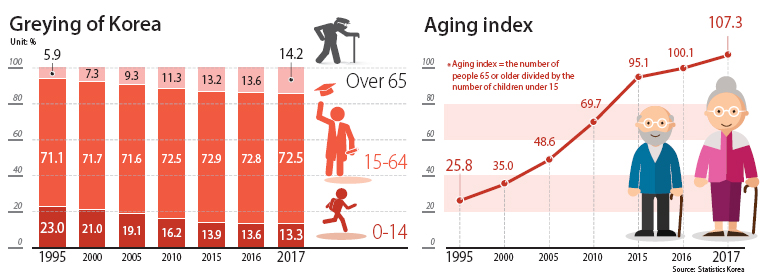Korea is now an ‘aged’ society

According to Statistics Korea on Monday, the number of working age Koreans - between the ages of 15 and 64 - fell by roughly 0.3 percent from 36.31 million in 2016 to 36.2 million last year. It is the first time that this number declined year-on-year since the statistics agency started collecting population data in 1949.
The number of people aged over 65 increased by 5 percent year on year to 7.11 million, accounting for 14.2 percent of the total population last year.
This officially makes Korea an “aged society,” which is defined by the United Nations as a society in which the population aged 65 or older exceeds 14 percent of the total population.
There is little hope that the working population can rebound as the number of people under the age of 15 keeps decreasing. Last year, the number of Koreans under the age of 15 amounted to 6.63 million, down 2 percent year on year.
The aging index - calculated by dividing the number of people over the age of 64 by the number of children below 15 - jumped to 107.3 from 100.1 in 2016.
By regions, South Jeolla showed the highest aging index of 171.5, followed by North Gyeongsang and Gangwon. Sejong, where many public servants moved to after government offices were relocated, had the lowest aging index of 45.5.
Korea has been aging fast especially since 2000, when it officially became an “aging society,” in which the population over 64 accounts for over seven percent of the total population.
While it took 24 years for Japan to transition from an aging society to an aged one - from 1970 to 1994 - it only took Korea 17 years.
“The projection that the working age population will peak in 2017 has become a reality,” said Nam Sung-il, a professor of labor economics at Sogang University. “As the working age population is also the consuming population, this means production and consumption will both shrink in the future.”
Nam advised Korea to look at Japan’s policies focused on maintaining the working age population by encouraging the elderly to work.
“The important thing is to maintain the country’s total production and consumption levels [regardless of demographic changes,]” Nam added.
“There also needs to be discussions on whether Korea’s pension system can hold,” said Park Ga-yeol, a researcher at Korea Employment Information Service. “The current system passes the buck to our future generation.”
Nam advised Korea to bring in more foreigners. “In countries with gross domestic per capita exceeding $30,000, foreigners generally account for about 10 percent of the total population except for Japan,” Nam said.
According to Statistics Korea data, the non-Korean population residing in Korea amounted to 1.48 million, accounting for 2.9 percent of the total population last year. The total number has increased 4.6 percent since 2016.
BY KIM JEE-HEE, SUH YOU-JIN [kim.jeehee@joongang.co.kr]










with the Korea JoongAng Daily
To write comments, please log in to one of the accounts.
Standards Board Policy (0/250자)